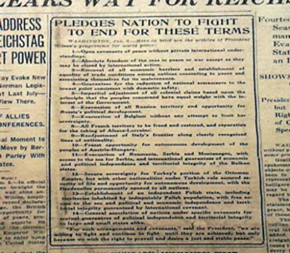Teacher Guide
Teacher Guide
Lesson 4: The Korean Independence Movement

March 1st Movement, circa 1919.
(Source: WIkipedia)
Lesson Features
-
- TOPICS: Korean Independence Movement, Wilson’s 14 Points, Korean American identity
- HISTORICAL TIMEFRAME: 1910 – 1950
- SUMMATIVE ASSESSMENT: Compose persuasive letter
Lesson Overview
-
- Students situate President Woodrow Wilson’s Fourteen Points Peace Program and 1919 speech to congress in the development of the Korean Independence Movement. They engage in a jigsaw activity and examine original documents and news reports from the time period to identify how the Korean Independence Movement shaped and was shaped by the formation of the Korean American identify in the United States. Students compose a letter to President Wilson to encourage the United States to support the Korean Independence Movement.
Timeframe
-
- Activity 4.1 requires 55 minutes.
- Activity 4.2 require at least two 55-minute class periods.
- The Summative Assessment Letter to President Wilson will also require at least one 55-minute period or may be completed as homework.
Objectives and Learning Goals
-
- Students will be able to identify elements of Wilson’s Fourteen Points that impacted the Korean Independence Movement.
- Students will be able to analyze how events in Korea and the United States shaped and were shaped the formation of the Korean American identity and Korean Independence Movement.
- Students will be able to compose a clear and coherent persuasive letter.
- Students will be able to evaluate multiple sources of information presented in diverse formats and media (e.g., visually, quantitatively, as well as in words) in order to understand factors that shaped the formation of the Korean American Identity.
Vocabulary
-
- Activist – a person who campaigns to bring about political or social change.
- Annexation – the administrative and usually illegal action relating to the forcible acquisition of one state’s territory by another state.
- Colonialism – the policy or practice of acquiring full or partial political control over another country, occupying it with settlers, and exploiting it economically.
- Independence – condition of a nation, country, or state in which residents and population, or some portion thereof, exercise self-government, and usually sovereignty, over its territory.
- Imperialism – a policy of extending a country’s power and influence through diplomacy or military force.
- Occupation – the takeover and control of one country by another.
- Self Determination – the process by which a country determines its own statehood and forms its own allegiances and government.
- Sovereignty – the authority of a state to govern itself or another state.
Original Resource
-
- Park, E., Kang, EJ & Kwon, H. (2022). The Korean Independence Movement. In G. Cho & V. Costa (Eds.). Korean American Ethnic Studies Curriculum: Teaching Resource Materials for K-12 Classrooms (pp.159-222). Consulate General of the Republic of Korea in Los Angeles.
Lesson 4 Presentation (PDF)
Lesson 4 Presentation Teacher’s Guide (PDF)
Download Lesson 4 Presentation (PPT)

